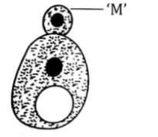MEDIUM
Earn 100
Which one is common to multicellular fungi, filamentous algae and protonema of mosses?
50% studentsanswered this correctly
Important Questions on Reproduction in Organisms
HARD
MEDIUM
EASY
EASY
EASY
Identify the asexual reproductive structure in the following diagram:

EASY
EASY
EASY
EASY
Match the following
| List-I | List-II | ||
| (A) | Longitudinal binary fission | (I) | Paramoecium |
| (B) | Transverse binary fission | (II) | Amoeba |
| (C) | Sporogony | (III) | Pleurobrachia |
| (D) | Sporulation | (IV) | Plasmodium |
| (V) | Euglena |
EASY
MEDIUM
MEDIUM
MEDIUM
MEDIUM
MEDIUM
EASY
MEDIUM
